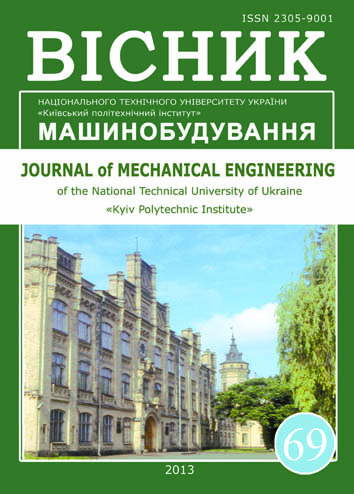MODELING OF FORGING PROCESS IN ASYMMETRIC COMBINED ANVILS
DOI:
https://doi.org/10.20535/2305-9001.2013.69.28994Keywords:
forging, deformation, shear, finite element method, anvils, regimeAbstract
Purpose. The aim of this paper is in investigation of strain-stress state of billet during the forging by asymmetric anvils and determining of them dimensions which provide high level of shear deformations.
Design/methodology/approach. Researches were made by the finite element method. Boundary conditions are the next. Diameter of billet 1000 mm, width of anvils 1000 mm. Relative feed is one. Material of billet is steel with carbon content 0.35%, initial temperature of billet is 1100 0C, of instrument is 20 0C. Heat transfer coefficient is 5 W/m2 0C. Friction coefficient by Zibel law is 0.35, speed of anvils move is 10 mm/sec.
Findings. It is determined influence of tools geometric parameters in forging processes upon to level of shear deformations in billet.
Originality/value. The recommendations of determining the tools parameters and regime of forging process which are provide a high level of shear deformations in billet were given.
References
Kun Chen, Yitao Yang, Guangjie Shao, Kejia Liu. Strain function analysis method for void closure in the forging process ofthe large-sized steel ingot. Computational Materials Science, 2012, No.51, pp. 72–77
Banaszek G., A. Stefanik. Theoretical and laboratory modelling of the closure of metallurgical defects during forming of a forging. Journal of Materials Processing Technology, 2006, No.177, pp. 238–242
Park C.Y., D.Y. Yang A study of void crushing in large forgings II. Estimation of bonding efficiency by finite-element analysis. Journal of Materials Processing Technology, 1997, no.72, pp. 32–41
Aliev I.S., Ja.G. Zhbankov, O.E. Markov, S.A. Bliznjuk. Vlijanie operacii vyvorota pokovki konicheskimi plitami na raspredelenie deformacij. Obrabotka metallov davleniem: Sbornik nauchnyh trudov. Kramatorsk: DGMA, No. 3(24), 2010 – pp. 64-68.
Guljaev A.P. Metallovedenie. Moscow: Metallurgija. 1986. 544 p.
Tjurin V.A. Mehanizm plasticheskogo deformirovanija s makrosdvigami. Izvestija vuzov. Chernaja metallurgija, 1998, No.12 pp. 36-39.
Najzabekov A.B., Zh.A. Ashkeev, S.N. Lezhkov Rol' sdvigovyh deformacij v zakrytii vnutrennih defektov. Izvestija vuzov. Chernaja metallurgija, 1999, no.1.0 pp. 20-22.
Segal V.M., V.I. Reznikov, D.A. Pavlik Tehnologicheskie osobennosti kovki-protjazhki s prodol'nym sdvigom bojkov. Kuznechno-shtampovochnoe proizvodstvo, 1980, No. 1. pp. 8-10.
Ohrimenko Ja.M. Povyshenie jeffektivnosti i kachestva raboty v kuznechnom proizvodstve. Kuznechno-shtampovochnoe proizvodstvo, 1977, no.8. pp. 2-7
Kotelkin A.V., Petrov V.A. (SSSR). Kombinirovannye bojki: A.s. 774756 SSSR, MKI B 21 J 13/22. No. 2715513; Zajavleno 23.01.79; Opubl. 30.10.80, Bjul. No.40.

